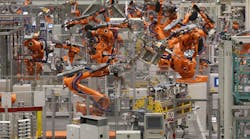In Part 1 and Part 2 of our series on the Factory of the Future we looked at definitions and characteristics of companies embracing the disruptive technologies causing a paradigm shift in manufacturing. In this next installment, we look at the benefits of taking bold steps toward becoming a Factory of the Future.
Profitability and longevity are indisputable benefits of adopting a modernization strategy and becoming a Factory of the Future. No matter how many ancillary benefits you can list, the bottom line must come back to revenue gained and reduction in spending or waste. Profits keep manufacturers able to invest in research, equipment and the highly skilled workers, like data scientists, required to maintain strategic planning and activities. Without continuing to invest, the company risks falling to the back of the pack while competitors pass in the fast lane.
Longevity means the company can stay in the race and sustain the level of quality, innovation, and value that the customer expects. Modernization provides systems that are more than quick fixes or short-term trends. The technology adopted by the digital enterprise is highly flexible so it can grow and evolve as the company expands. Flexible architecture is an important element, allowing the company to integrate new capabilities as they are developed.
Benefit of IoT Strategies
The Internet of Things promises to be the disruptive technology that will bring the largest benefits to manufacturers who are ready to embrace sensor tracking capabilities and the many spin-off applications. Although value estimates vary, the projections are in the trillions. McKinsey anticipates the global economic value to be $11 trillion and Cisco predicts a $19 trillion opportunity.
The estimated value-at-stake will be created by the combination of increased revenues and lower costs. In one projection, Cisco outlines the potential gains in five key areas of opportunity:
- Asset utilization ($2.5 trillion) — IoT reduces selling, general, and administrative (SG&A) expenses and cost of goods sold (CoGS) by improving business process execution and capital efficiency.
- Employee productivity ($2.5 trillion) — IoT creates labor efficiencies that result in fewer or more-productive man-hours.
- Supply chain and logistics ($2.7 trillion) — IoT eliminates waste and improves process efficiencies.
- Customer experience ($3.7 trillion) — IoT increases customer lifetime value and grows market share by adding more customers.
- Innovation, including reducing time to market ($3.0 trillion) — IoT increases the return on R&D investments, reduces time to market.
Predicting Trends and Consumer Preferences
The digital modernization strategy also provides for the continuous evaluation of changing demands and new opportunities. The manufacturer will be able use advanced tools to monitor shifts in customer buying trends and forecast changing impact of inventory and scheduling. The modern enterprise also takes into consideration continuous process improvement. No manufacturers can rest on past laurels in this highly competitive market, but must continue to refine processes and products to meet evolving expectations—whatever they may be.
Benefits of being a smart manufacturer or Factory of the Future are not only customer facing. Although customer centricity is an important part of the modernization strategy, a thorough refresh of technology needs to be applied throughout the organization.
McKinsey points out in “Seven traits of an effective digital organization” that back-office benefits are equally important. “Many organizations focus their digital investments on customer-facing solutions. But they can extract just as much value, if not more, from investing in back-office functions that drive operational efficiencies. A digital transformation is more than just finding new revenue streams; it’s also about creating value by reducing the costs of doing business,” the report states.
It goes on to say, “Investments in digital should not be spread haphazardly across the organization under the halo of experimentation. A variety of frequent testing is critical, but teams must quickly zero in on the digital investments that create the most value—and then double down. Often, great value is found in optimizing back-office functions.” The report also provides an example of manufacturing giant Procter & Gamble collaborating with Los Alamos National Laboratory to use statistical methods to streamline processes and improve the uptime of plants. The result was a savings of more than $1 billion a year.
These substantial benefits make it clear why the Factory of the Future is a topic that is making manufacturers take a closer look at their IT and OT systems. With so much at stake, who can afford to be sitting on the sidelines? It’s critical to start laying the foundation now.
For help getting started on modernizing your operations, check out this comprehensive 2015 Manufacturing Guide.




